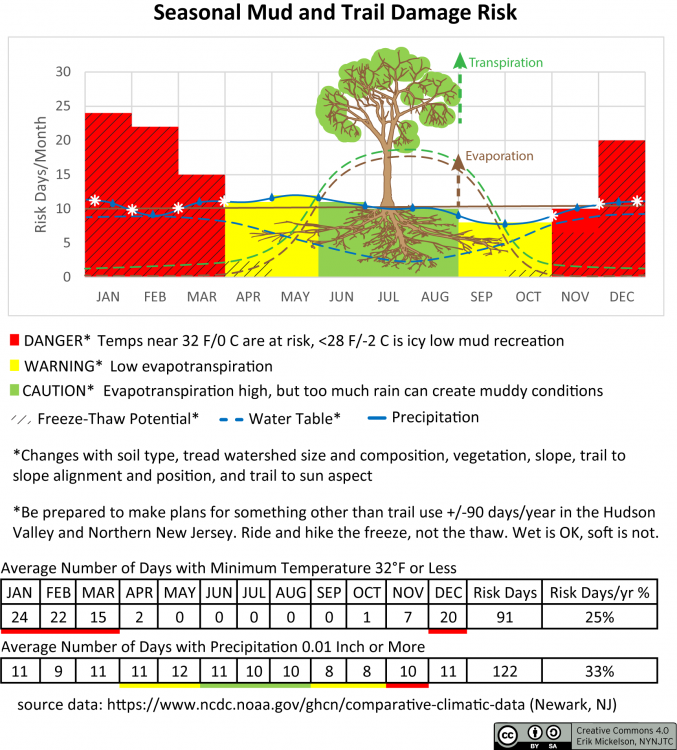Mud can be a seasonal or intermittent downer for most trail users throughout the world. It can be damn fun and novel as a kid or in a 4×4 or on an ATV, but ultimately not fun cleaning up the mess at home or dealing with the aftermath as a trail maintainer. While mud is usually a centerpiece of things like boot camp, Tough Mudders, monster truck events, and some wrestling venues, in some circles its more than a little disrespectful and inconsiderate to use muddy trails, especially those open to the general public (yikes). In some places, like southern California for example, footprints and wheel ruts can harden quickly and stay for for months until the next rain event makes the soil plastic enough to smooth again.
Some climates have seasonal mud risks that can last several months. Below is a graphic for North America near New York City:

Why Mud?
Mud is soft because the friction and cohesion between soil particles is lowered with water, which acts like a lubricant and helps them slide or shear past each other. In technical terms, the bearing capacity or shear strength of the soil is lowered with water. As the trail dries from a liquid or plastic state the bearing capacity or shear strength increases. Some soil types are harder to shear, and drain quickly so they are less susceptible to displacement. Some soils turn nearly to concrete when compacted and dry, others can shear more easily when they dry beyond a certain soil moisture level.
What is Mud?
Mud isn’t a feature of a trail compacted by it’s builders and it’s users. Trails typically just get wet and perhaps plastic, not muddy. Users shearing the trail bed into soil stew makes mud. The trail was fine until someone planted a foot or tire on a wet trail tread surpassing the trail soil’s bearing capacity (shear rudeness or ignorance in many cases).
Freeze-Thaw Mud
Freeze-thaw cycles reduce compaction, and it is compaction that helps with trail bearing capacity. Regretfully every year some areas have seasons of susceptibility and some soils get opened up or tilled and loosened to some degree by freeze-thaw cycles. This reduces compaction and the bearing capacity (at least in the top few inches of soil). During freeze-thaw sometimes only a few fractions of an inch melt on top of a layer of soil ice below, turning the surface into a soil soup (of shearing). Some areas hit rewind almost every year depending on how much freezing and thawing occurs. Trail traffic can help compact expanded trail beds back into a stronger state when the soil moisture content is ideal (details here and here), but chances are it’s going to get messed up again in the winter and shoulders of the season.
Erosion vs Displacement
Erosion usually refers to the movement of soil off the trail from water flow, and displacement refers to the movement of soil off the trail from wind or users mechanically squishing it out of shape or displacing it by moving it off the trail as they would in the case of mud on shoes and tires or from slipping and skidding on drier soil.
Trail Closed
Displacement from ruts and footprints can create voids that help hold water which can extend the drying time as well as provide a spot for ice formation and in turn may also extend melting and drying times. See the potential for a cycle? Break it by staying off of wet trails. Ultimately using trails when soft creates mud, and it prolongs the trail returning to more ideal moisture contents that support traffic.
Snow and Ice
When snow melts it might as well have just rained. Regretfully it’s not going to dry as fast in colder months because evaporation rates are low, as is transpiration from plants. See the image above, and this piece on snow water equivalents.
Beyond the Mud
Most people not hip to the etiquette of trail puddles and mud are apt to go around them. This is not a problem on wider paths or roads, but on single track it could mean a wider trail. Keep single track single by going through puddles.
Beyond the widening of trails, widen your list of things to do if you can’t or shouldn’t use the trails because they are too wet to bear it. Other hobbies, paved paths and roads anyone?